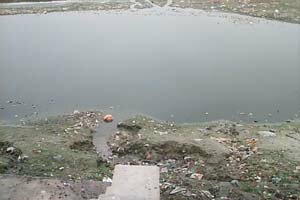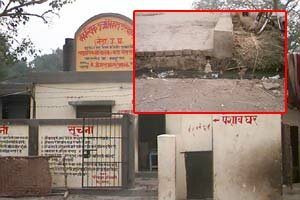|
 If Prime Minister Atal Behari Vajpayee visits Sarsaiya Ghat today, more than nostalgia a feeling of disbelief would grip him. It was on this picturesque ghat that young Vajpayee, then pursuing his studies, composed many of his verses. There was a time when the tolling of the bells could be heard as you approached Sarsaiya Ghat. Shoals of devotees paid their obeisance to the holy Ganga which touched the ghats then. A line of umbrellas could be seen under whose umbrage priests helped the visitors make their offerings. Poets found it an ideal place for catharsis and creativity. Nauka vihar (boat ride) was a pleasure that many visitors exulted in. All that has been consigned to the pages of history now. The bells have fallen silent, the ghats are an unfrequented place. The boats lie astray and are languishing. Since the 1960s the shifting of the river Ganga from its usual course has left the ghats empty and abandoned. Hardest hit are the communities that depended on the river for their livelihood. If Prime Minister Atal Behari Vajpayee visits Sarsaiya Ghat today, more than nostalgia a feeling of disbelief would grip him. It was on this picturesque ghat that young Vajpayee, then pursuing his studies, composed many of his verses. There was a time when the tolling of the bells could be heard as you approached Sarsaiya Ghat. Shoals of devotees paid their obeisance to the holy Ganga which touched the ghats then. A line of umbrellas could be seen under whose umbrage priests helped the visitors make their offerings. Poets found it an ideal place for catharsis and creativity. Nauka vihar (boat ride) was a pleasure that many visitors exulted in. All that has been consigned to the pages of history now. The bells have fallen silent, the ghats are an unfrequented place. The boats lie astray and are languishing. Since the 1960s the shifting of the river Ganga from its usual course has left the ghats empty and abandoned. Hardest hit are the communities that depended on the river for their livelihood.
They are a despondent lot today. Chotelal Diwedi, a septuagenarian who has been mute onlooker to the decay of the Sarsaiya Ghat in Kanpur says, "This historic ghat was clean and tourists flocked to it four decades back. Ganga used to flow at the ghat. But now, the river has gone away from the shores more than two kilometres and the ghat is filthy as never before. People do not come to this place anymore."
He is right. Because of Ganga's geographical change of course, the ghat has been utterly neglected. The Ganga Barrage which was mooted in the late 1960s to bring the waters back to the banks and to be built by 2003 has been dubbed as an eyewash. Against such a backdrop, Sarsaiya Ghat has turned a hotbed of pollution putting the livelihood of the 300 odd families staying close to it at stake. These communities depended on fishing, boating and Ganga-related rituals to eke out a mere existence.
The Sarsaiya Ghat is located adjacent to the Kanpur Jail which houses around 1,800 inmates. Under Ganga Action Plan Phase I, the drains through which the wastewater of the Jail is dumped into the Ganga were proposed to be tapped through interception and diversion. However, the pipelines to divert the drains have got damaged and now the sewage water passes through the shanties in open and foul the Ganga. Residents say that in monsoons, the drains overflow and they have to wade through the sewage water. Contact with this water triggers a host of skin problems. Ganga turns dirtier as the waste from Bakarmandi slaughter house also finds its way into the river. Besides this, as there is no solid waste disposal system in the locality, the waste gets piled up. People residing in the area complain that sweepers don't come to collect the garbage for days together. Thus, the Ganga becomes a dumping yard for garbage.
 Worse, the residents are also bearing the brunt of the loopholes that have surfaced in the community latrine cum biogas project launched in 1997 by Non Renewable Energy Development Agency (NEDA). The aim of the project was to stop open defecation by the communities living in the vicinity. The maintenance charge levied by NEDA on the community at Rs 30 per family/ per month has now increased to Rs 45 per family/ per month which is not affordable, claims Laxman Prasad Dixit, a member of Human Rights Association of India. A ghat resident, Hariom Diwedi. points out that in the morning when everybody prefer inhaling fresh air, the residents of Sarsaiya Ghat are forced to breathe the obnoxious gas let out by the biogas plant. To top this all, under the project it was planned that waste of the community latrine would be directed towards a drain and will be treated before it mixes with Ganga. Today, the water from the community latrine goes directly into the Ganga. Says Rakesh Jaiswal of EcoFriends, "There were provisions for setting up public lavatories along the Ganga under GAP I. The purpose was to discourage open defecation and facilitate the community in 'attending the call of nature'. However, the NEDA project has fallen on both counts. Neither has it been able to stop open defecation nor has it been able to involve the community in Ganga clean-up. Paradoxically, the NEDA project has itself become a source of pollution for the river." Worse, the residents are also bearing the brunt of the loopholes that have surfaced in the community latrine cum biogas project launched in 1997 by Non Renewable Energy Development Agency (NEDA). The aim of the project was to stop open defecation by the communities living in the vicinity. The maintenance charge levied by NEDA on the community at Rs 30 per family/ per month has now increased to Rs 45 per family/ per month which is not affordable, claims Laxman Prasad Dixit, a member of Human Rights Association of India. A ghat resident, Hariom Diwedi. points out that in the morning when everybody prefer inhaling fresh air, the residents of Sarsaiya Ghat are forced to breathe the obnoxious gas let out by the biogas plant. To top this all, under the project it was planned that waste of the community latrine would be directed towards a drain and will be treated before it mixes with Ganga. Today, the water from the community latrine goes directly into the Ganga. Says Rakesh Jaiswal of EcoFriends, "There were provisions for setting up public lavatories along the Ganga under GAP I. The purpose was to discourage open defecation and facilitate the community in 'attending the call of nature'. However, the NEDA project has fallen on both counts. Neither has it been able to stop open defecation nor has it been able to involve the community in Ganga clean-up. Paradoxically, the NEDA project has itself become a source of pollution for the river."
There are 26 zenana (female) changing rooms that were constructed by the British near the ghat to give the womenfolk privacy. But all of them lie in a dilapidated state. The ghats were last repaired in 1962 by one businessman, Lala Changamal. Since four decades, no government official has visited the place. Even though the government earns a hefty amount from the 25 fetes organised here, it has done nothing for the upliftment of the community or the restoration of the ghats. Locals say that the roofs of most ghats are almost coming down. Tourists are at a peril while visiting the ghats during auspicious occasions.
Sarsaiya Ghat speaks volumes of how the Kanpur banks have been deserted and neglected with the shifting of the river course. As a backlash, there are many communities which have been dislodged of their livelihood. They have no option but to suffer in silence. It is being believed that the Ganga Barrage would bring back the lost glory of the ghats and revive the fortune of the deprived communities. But would it really and how soon? The answer is elusive.
|
